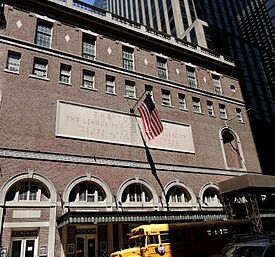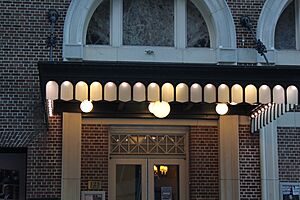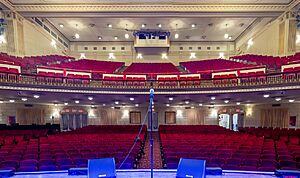The Town Hall (New York City) facts for kids
 |
|
| Address | 123 West 43rd Street Manhattan, New York City United States |
|---|---|
| Coordinates | 40°45′22″N 73°59′05″W / 40.7560°N 73.9847°W |
| Owner | Town Hall Foundation, Inc. |
| Capacity | 1,495 |
| Construction | |
| Built | 1919 |
| Opened | January 12, 1921 |
| Years active | 1921–present |
| Architect | Teunis J. van der Bent of McKim, Mead & White |
|
Town Hall
|
|
| Area | 12,563 square feet (1,167 m2) |
| Architectural style | Late 19th and 20th century revivals, Neo-Federal |
| NRHP reference No. | 80002724 |
| Significant dates | |
| Added to NRHP | April 23, 1980 |
| Designated NHL | March 2, 2012 |
The Town Hall is a famous performance hall located at 123 West 43rd Street in New York City. It's right in the middle of the busy Theater District near Times Square. Built between 1919 and 1921, it was first created as a place for people to hear speeches and learn about important topics.
The building was designed by the famous architecture firm McKim, Mead & White. It has a beautiful auditorium with 1,500 seats. Over the years, it became one of the city's top spots for concerts, recitals, and even film screenings. Because of its history and beautiful design, both the outside and inside of The Town Hall are protected as New York City landmarks.
Contents
Building The Town Hall
The Town Hall was built for a group called the League for Political Education. This group was started in 1894 by women who were fighting for the right to vote, known as suffragists. They wanted a special building where people could gather to discuss important ideas.
The League chose a spot on 43rd Street because it was close to many forms of transportation. Construction began in 1919. On January 24, 1920, Theodore Roosevelt Jr., the son of President Theodore Roosevelt, laid the building's cornerstone, a special first stone in a building's foundation.
The Town Hall officially opened on January 12, 1921. It was an instant success. In its first year alone, 200,000 people visited. The building was so important that it was seen as a symbol of democracy and open discussion, much like a traditional New England town hall.
A Look Inside and Out
The Town Hall was designed in the Georgian Revival style, which was popular for its connection to early American democracy. The building was made to look welcoming and important.
The Building's Exterior
The outside of The Town Hall, also called the facade, is made of brown brick with light-colored limestone details. The ground floor has seven large arched doorways that welcome visitors. Above the doors are steel-and-glass canopies with round lamps that light up the entrance at night.
The middle of the building features a large limestone plaque. It honors the League for Political Education and includes the quote: "Ye Shall Know the Truth and the Truth Shall Make You Free." This means that learning the truth gives people freedom.
The Grand Interior
Inside, a large lobby leads to the main auditorium. The lobby has a tile floor and decorated columns, giving it a classic, elegant feel.
The auditorium is the heart of The Town Hall. It has seats on a main floor (the orchestra) and in a large balcony. The designers worked hard to make sure every seat had a perfect view of the stage. This led to the hall's famous saying: "Not a bad seat in the house." The balcony was built without columns, so no one's view is blocked.
The walls are decorated with beautiful carvings, and the plaster ceiling has a pattern of sunken panels called coffers. A large, fancy chandelier hangs from the center of the ceiling, with smaller ones placed around it.
A Place for Speeches and Ideas
The Town Hall was originally created for lectures and debates. One of its most famous programs was a radio show called America's Town Meeting of the Air.
America's Town Meeting of the Air
The show was created in 1934 by George V. Denny Jr., who believed it was important for Americans to hear many different viewpoints. The show premiered on May 30, 1935, and was broadcast live from The Town Hall on the NBC Blue Network.
Each week, experts would debate important topics, and the audience could ask questions. The show was very popular and helped make The Town Hall famous across the country. It aired for over 20 years, until 1956.
Famous Speeches
Many important people have spoken at The Town Hall. In its first week, suffragist Carrie Chapman Catt and General John J. Pershing gave speeches. Other famous speakers included authors like Thomas Mann, politicians like Winston Churchill, and activists like Jane Addams.
In 1921, Margaret Sanger was arrested on stage for trying to speak to an audience of both men and women about family planning. In 1971, a famous debate about feminism was held there, which was later turned into a movie called Town Bloody Hall.
A World-Famous Music Hall

Although it was built for speeches, The Town Hall quickly became a major venue for music. Its excellent acoustics, meaning the way sound travels in the room, made it perfect for concerts.
Classical and Folk Music
The first musical event was a violin recital in February 1921. Soon, famous classical musicians from around the world were performing there. Composer Richard Strauss held concerts, and cellist Pablo Casals made his debut.
In 1935, contralto singer Marian Anderson performed at The Town Hall after other venues turned her away because she was African-American. The famous Von Trapp family singers, whose story inspired The Sound of Music, also performed there in 1938.
The Home of Jazz
The Town Hall played a huge role in the history of jazz music. In the 1940s, guitarist Eddie Condon hosted a popular series of jazz concerts that were even broadcast on the radio.
A 1945 concert featuring Dizzy Gillespie and Charlie Parker is considered the first major performance of a new jazz style called bebop. In 1947, a concert with Louis Armstrong was so successful that it led to the formation of his famous band, Louis Armstrong and His All Stars. Many famous live jazz albums have been recorded at the hall.
Challenges and Revival
By the 1950s and 1960s, The Town Hall became less popular. Other venues like Lincoln Center opened, and the Times Square area was becoming run-down. In 1958, New York University (NYU) took over the building, but it continued to struggle financially.
In 1978, NYU announced it would close the auditorium. Many people were worried the historic building would be torn down. A group called the Committee to Save Town Hall was formed to protect it. Their efforts worked, and the city declared the building a landmark, which saved it from demolition.
In 1979, a new nonprofit group, The Town Hall Foundation, took over. They began raising money to restore the building. In 1984, The Town Hall closed for a few months for a major renovation. The facade was cleaned, and the auditorium was carefully restored to its original beauty.
The Town Hall Today
Today, The Town Hall is once again a busy and beloved performance venue. It hosts a wide variety of events, including concerts, dance performances, comedy shows, and film festivals.
The Town Hall Foundation also runs educational programs for public school students. It continues its tradition of jazz concerts with its "Not Just Jazz" series. The popular radio show Live from Here often broadcasts from its stage. Thanks to the people who fought to save it, The Town Hall remains a vibrant part of New York City's cultural life.
See also
 In Spanish: The Town Hall para niños
In Spanish: The Town Hall para niños





